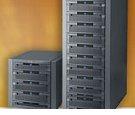
The Situation
How will Vasanth Kumar check data growth and its complexity? This question has been haunting senior IT managers across industries.
Kumar is also the victim of rampant data growth and the complexity that it throws up, putting undue pressure on operations and the bottom line. This senior IT manager of a large manufacturing group finds that storage consumption is escalating with more and more terabytes being deployed.
He has been implementing a variety of backup strategies and deploying all necessary tools, but the problem doesnt seem to go away. Obviously, cost pressure is going up and managing and maintaining so many tiers is becoming an increasingly cumbersome process. His challenge is not just in storing data, but also protecting it against growing security threats. The key challenge is around categorising the data and applications and evolving an appropriate DR plan, while ensuring these are made available in real time, with 24x7 uptime.
After deliberations and interactions with his peers in the industry, Kumar has decided to try out unified storage combined with a virtualised IP storage strategy. Since Kumar has never laid his hands on these tools before, the challenge for him is to ensure that they are uncomplicated and versatile in nature.
Certain inherent questions confront Kumar and he must justify his decision for a unified approach to the top management.
The pertinent questions are around whether the unified storage along with virtualised storage operations help in rapid deployment, embedded with a fully functioning array. Will it seamlessly grow without disrupting business operations; have standards-based design for simplicity, compatibility and affordability; integrate with leading server virtualisation solutions to enable cost-effective shared storage and so on?
Another fear that Kumar faces is in understanding whether the new storage strategy will simplify his task and provide advance automation; drive extensive application integration, and enable seamless snapshot, replicate, clone and the like.
The main issue here is the increase in data growth which puts pressure on the limited storage at the companys disposal. Before implementing a unified storage solution, Kumar has to first analyse the origin of the data types and forms. A clear insight into the user classification, systems and processes that create data and its size, the periodicity of retention and its criticality is necessary. There can be some user-specific data which should not, in the first place, be stored in the common network folders.
The big questions:
First Question: What kind of unified storage and virtualised IP storage solution does Kumar need to evaluate and deploy? Which key elements does he need to include to arrive at a unified storage model?
Second Question: How will these solutions help him address his data complexities and reduce the cost of storage operations? What steps does he need to follow in deploying unified storage and virtualising storage?
Answers from Sivakumar Krishnan, Head IT, Bhartiya Samruddhi Finance Ltd
First Answer
These should ideally be stored in the local hard disc of the users desktop.
There can be some temporary data which are transient in nature and can be deleted within a day or two. Even if they need to remain in the network drives, the same may be excluded from the backup. Hence, identifying the data becomes critical for sizing the expected growth and for capacity-planning of the storage and short-listing the backup solution to be adopted. It will also help in the migration process.
Unified storage meets the requirement of having NAS (Network Attached Storage) as well as SAN (Storage Area Network) in a single box. It also supports Fibre Channel. Kumar needs to evaluate unified storage for the following reasons. Depending on the nature of data, he should decide how the data will be stored - block based (recommended for mission-critical applications/ERP) or file based. The speed of I/O, swiftness of file sharing and data reliability will be critical. Consider the features and functionalities that come with the storage solution, including snapshot storage (for online file recovery), inbuilt backup application (NDMP) and replication. A facility to assign a specific disc quota to users/groups/trees should also be considered, along with Raid, volume management, files system creation, volume expansion and thin provisioning.
Second Answer
Deploying unified storage in its full form will enable him to address his challenges. It will help in the following areas:
1. Reduce hardware requirement, since there is a single device that can be deployed with
either block (Raid disc) or file storage (NAS)
2. Simple to manage. One box rather than multiple boxes.
3. User-friendly GUI will make the administrators job look easy with just one resource
4. Trying the dedupe will maximise block storage capabilities, enabling faster retrieval
with less power consumed
5. Reduce TCO
6. Wizard-based setup and configuration tools will help with easier management
7. VMware, along with unified storage, will reduce server footprints
8. Virtual IP allocation to varied departments will avoid virus attack and spread
(Continue to the next page for more expert answers)

 In
In
Add new comment